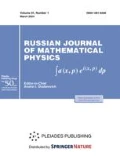Abstract
A phase transition of the first kind is a jump of a function, a phase transition of the second kind is a jump of its first derivative, a phase transition of the third kind, a jump of the second derivative. A phase transition from one statistic to another is very gradual, but finally it is as considerable as the phase transition of the first kind. However, we cannot introduce a clearly defined parameter to which this transition corresponds. This is due to the fact that the fluctuations near the critical point are huge, and this violates, in the vicinity of that point, the main law of equilibrium thermodynamics, which asserts that fluctuations are relatively small.
The paper describes the transition in the supercritical fluid region of equilibrium thermodynamics from parastatistics to mixed statistics, in which the Boltzmann statistics is realized for long-living clusters. In economics this corresponds to a negative nominal credit rate. Examples of this non-standard situation are presented.
Similar content being viewed by others
References
V. P. Maslov, “The Mathematical Theory of Classical Thermodynamics,” Math. Notes 93(1), 102–136 (2013).
V. P. Maslov and T. V. Maslova, “A New Approach to Mathematical Statistics Involving the Number of Degrees of Freedom, Temperature, and Simplectical Conjugate Quantities,” Russ. J. Math. Phys. 20(3), 315–325 (2013).
V. P. Maslov, “A Mathematical Theory of the Supercritical State Serving As an Effective Means of Destruction of Chemical Warfare Agents,” Math. Notes 94(4), 532–546 (2013).
A.N. Esina and A.I. Shafarevich, “Quantization Conditions on Riemann Surfaces and the Spectrum of the Schrödinger Operator with Complex Potential,” Math. Notes 88(2), 61–79 (2010).
H. Roohian and A. I. Shafarevich, “Semiclassical Asymptotics of the Spectrum of a Nonself-Adjoint Operator on the Sphere,” Russ. J. Math. Phys. 16(2), 309–315 (2009).
H. Roohian and A. I. Shafarevich, “Semiclassical Asymptotic Behavior of the Spectrum of a Nonself-Adjoint Elliptic Operator on a Two-Dimensional Surface of Revolution,” Russ. J. Math. Phys. 17(3), 328–334 (2010).
A. I. Esina and A. I. Shafarevich, “Analogs of Bohr-Sommerfeld-Maslov Quantization Conditions on Riemann Surfaces and Spectral Series of Nonself-Adjoint Operators,” Russ. J. Math. Phys. 20(2), 172–181 (2013).
V. P. Maslov, “Critical Indices As a Consequence of Wiener Quantization of Thermodynamics,” Theoret. and Math. Phys. 170(3), 384–393 (2012).
V. P. Maslov and T. V. Maslova, “Economics As an Analog of Thermodynamics: Conjugate Variables,” Math. Notes 91(3), 442–444 (2012).
V. P. Maslov, “On the Appearance of the λ-Point in a Weakly Nonideal Bose Gas and the Two-Liquid Thiess-Landau Model,” Russ. J. Math. Phys. 16(2), 146–172 (2009).
V. P. Maslov, “Quasi-Particles Associated with Lagrangian Manifolds Corresponding to Semiclassical Self-Consistent Fields. III,” Russ. J. Math. Phys. 3(2), 271–276 (1995).
V. P. Maslov, “Bose-Einstein-Type Distribution for Non-Ideal Gas. Two-Liquid Model of Supercritical State and Its Applications,” Math. Notes 94(2), 237–245 (2013).
Author information
Authors and Affiliations
Rights and permissions
About this article
Cite this article
Maslov, V.P., Maslova, T.V. Parastatistics and phase transition from a cluster as a fluctuation to a cluster as a distinguishable object. Russ. J. Math. Phys. 20, 468–475 (2013). https://doi.org/10.1134/S1061920813040080
Received:
Published:
Issue Date:
DOI: https://doi.org/10.1134/S1061920813040080




